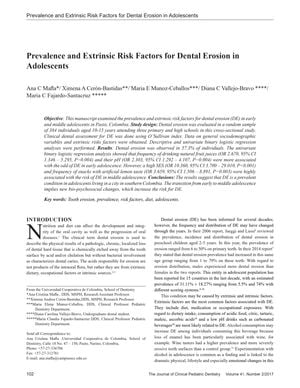Prevalence and Extrinsic Risk Factors for Dental Erosion in Adolescents
January 2017
in “
Journal of Clinical Pediatric Dentistry
”

TLDR Dental erosion is common in adolescents and is linked to diet and higher socioeconomic status.
In 2017, a study conducted in Pasto, Colombia, involving 384 adolescents aged 10-15 years, found a high prevalence of dental erosion (DE) at 57.3%. The study revealed that dietary habits, particularly the consumption of natural fruit juices, snacks with artificial lemon taste, and sour candies, were significant risk factors for DE. Additionally, a high socioeconomic status was associated with an increased likelihood of DE in both early and middle adolescence. The study concluded that DE is influenced by both dietary habits and socioeconomic factors, and highlighted the need for targeted oral health promotion and preventive strategies for adolescents. It also noted limitations such as its cross-sectional design, sample size, and reliance on self-reported data.